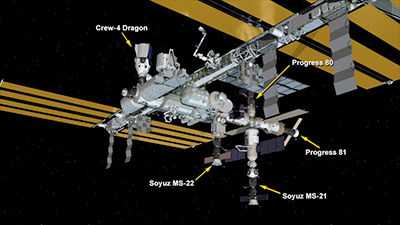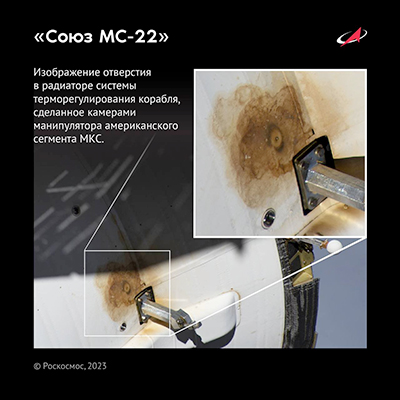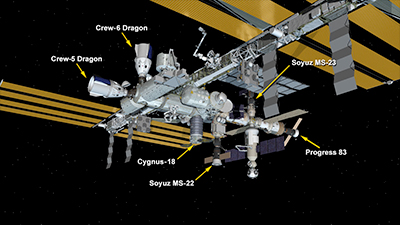 Space News space history and artifacts articles Messages space history discussion forums Sightings worldwide astronaut appearances Resources selected space history documents |
If you have previously registered, but forgotten your password, click here.
| ||||||||
| Headshot | I am curious to know if it just me, but on the majority of recent Soyuz crew photos that include a U.S. astronaut, the American flag on the left arm seems to be regularly obscured. I reviewed the crew photos on collectSPACE's Soviet Russian Space topic over the last year or so and none of them displayed the Stars and Stripes. Am I being paranoid? | |||||||
| Robert Pearlman | There are plenty of photos with each crew that show the U.S. flag on the shoulder of the NASA astronaut(s). For consistency sake, I tend to use the fit-check portrait with the three crew members sitting on the access ladder outside of their Soyuz. That area does not have enough room for all three to sit without overlapping each other and generally that means the commander sits up front with the two others seated slightly behind, resulting in one of their arms being obscured. But that's not always the case, as you can in the Soyuz MS-12 photo (for example), so there is really nothing purposeful or nefarious about it. | |||||||
| Robert Pearlman | NASA video Soyuz MS-22 is scheduled to lift off at 9:54 a.m. EDT (13:54 UTC) Wednesday, Sept. 21; NASA TV coverage will begin at 9 a.m. | |||||||
| Robert Pearlman | Current ISS configuration: | |||||||
| brianjbradley | Was the station ingress and welcome ceremony with family comments not broadcast via NASA TV this time? I think I saw 10 seconds of hatch opening on NASA TV, but plenty of coverage of Artemis I being fuelled. | |||||||
| Robert Pearlman | At about 7:40 p.m. EST on Wednesday (Dec. 14), flight controllers noticed a significant leak of an unknown substance from the aft portion of the Soyuz MS-22 spacecraft docked to the Rassvet module on the International Space Station. The leak is believed to have emanated from an exterior cooling loop. | |||||||
| Robert Pearlman | A brief update from NASA: The external radiator cooling loop of the Soyuz is the suspected leak source. | |||||||
| SpaceAholic | The Department of Defense is tracking the potential for undocking as early as tomorrow (17 December) and return to Kazakhstan. (DOD provides human spaceflight support to Soyuz missions when US crew are onboard.) | |||||||
| Robert Pearlman | Some updates via sources talking to Ars Technica: NASA will use the 17.6-meter-long Canadarm2—also known as the space station remote manipulator system—to get a closer look at the Soyuz spacecraft. It's hoped that this visual inspection, likely to take place over the weekend, will provide more definitive information on the source of the leak, its cause, and whether other elements of the Soyuz spacecraft were damaged. To facilitate this work, NASA will delay a spacewalk planned for Monday by astronauts Frank Rubio and Josh Cassada. | |||||||
| Robert Pearlman | Update from Roscosmos (English summary via Katya Pavlushchenko on Twitter): According to preliminary information, the damage could have been caused by the micrometeoroid or space debris hit into the external cooler radiator located on the service module of the Soyuz MS-22 spacecraft.Yuri Borisov, the head of Roscosmos, commented on the situation with Soyuz MS-22 to the media. He added a couple of important technical details to the Roscosmos statement (via Twitter): The diameter of the hole is about 0.8 mm. | |||||||
| Robert Pearlman | Groups of troubleshooters will gather for a meeting today (Dec. 27) to discuss the fate of the Soyuz MS-22 spacecraft, but no final decision will be made for the time being, the director of Roscosmos corporation’s crewed space programs, Sergei Krikalev, said on Monday. "A meeting is due tomorrow, but a final decision will not be taken for now. There will be a report by technical specialists and a technical decision made regarding the further mode of action and how the flight’s program should be changed," Krikalyov said. | |||||||
| Robert Pearlman | NASA will host a media teleconference at 9 a.m. EST on Wednesday, Jan. 11, to discuss results from the investigation of the Roscosmos Soyuz MS-22 external coolant leak and the forward strategy for uninterrupted human operations aboard the International Space Station. | |||||||
| Robert Pearlman | As announced by Roscosmos and NASA today, Soyuz MS-22 will return to Earth without a crew at the end of February, about a week after the now uncrewed Soyuz MS-23 will arrive and dock at the International Space Station. The primary concern with returning a crew to Earth on Soyuz MS-22 is that without a functioning coolant system, the temperature and humidity in the Soyuz would reach levels that would be unhealthy for anyone on board. Roscosmos expects the Soyuz MS-22 spacecraft to conduct a nominal reentry and land in Kazakhstan as usual. If an emergency occurs on the space station before the Soyuz MS-23 spacecraft can arrive on Feb. 20, requiring that the crew evacuate and return to Earth, then the plan is either to have all three Soyuz MS-22 crewmates lands on Soyuz MS-22 or perhaps transfer one crew member to Dragon. The plans for that unlikely scenario are still in work. Through the analysis of on-orbit imagery and through ground tests, Roscosmos has determined that the damage to Soyuz MS-22 was caused by a micrometeorite impact, which not only damaged the radiator but also the pipe that fed ammonia coolant to the radiator. The impact is in a location that is unreachable by crew members and even if it was, a repair and the refilling of the coolant would be too difficult to do in space. | |||||||
| SkyMan1958 | Just wondering, I realize the Sokol spacesuit is an IVA, but given that it is a spacesuit, shouldn't it be able to handle relatively high temperatures (still below boiling)? High humidity could be an issue. | |||||||
| Robert Pearlman | As a launch and entry suit, the Sokol suit is designed to protect its wearer for relatively brief exposures to extremes in the case of an emergency. According to Roscosmos, it is expected that the interior cabin of Soyuz MS-22 will be at 40 degrees Celsius (104 degrees Fahrenheit) for up to six hours. The suited crew might survive such exposure but it would neither be healthy or pleasant. | |||||||
| Robert Pearlman | Roscosmos released this photo of the damage area on the Soyuz MS-22 spacecraft as viewed from the Canadarm2 robotic arm: | |||||||
| Paul78zephyr | Has a decision been made as to when the (unmanned) Soyuz MS-22 spacecraft will return to Earth? Is it docked near to where the newly arrived Soyuz MS-23 spacecraft is docked? Also will it carry any special cargo back from the ISS? | |||||||
| Robert Pearlman | Soyuz MS-22 is currently scheduled to undock and land from the space station on March 28. Soyuz MS-22 is docked to Rassvet mini-research module, while Soyuz MS-23 is docked to the zenith port of the Poisk mini-research module on the opposite side of the space station.  I believe Sergei Krikalev earlier mentioned that some science results and cargo was to be packed on Soyuz MS-22, taking the place of the crew, but no details were given. | |||||||
| Paul78zephyr | Robert, thank you so much for that info/update. | |||||||
| issman1 | I knew it would make a successful re-entry, descent and landing. | |||||||
| Robert Pearlman | It did, but it would have been near disastrous for any crew aboard. Though an initial report suggests the thermal conditions aboard Soyuz MS-22 were better than the predicted worst-case scenarios, it would have been about 122 degrees Fahrenheit (50 degrees Celsius) if there had been two crew members aboard for the return. Soyuz MS-22 did return (480 pounds) 218 kilograms of cargo in the cosmonauts' place. According to Roscosmos (via Russian Space Web): Items to be returned included materials from science experiments, such as Neiroimmunitet, Biomag-M, Fotobioreaktor, Probiovit, Struktura, Fagen, MSK-2 and 3D Printer. In addition, some unidentified hardware from the Soyuz-MS spacecraft, including wide-band communications equipment, control avionics, air-conditioning systems, water and urine recycling components and oxygen producing equipment would also be returned, the State Corporation said. | |||||||
